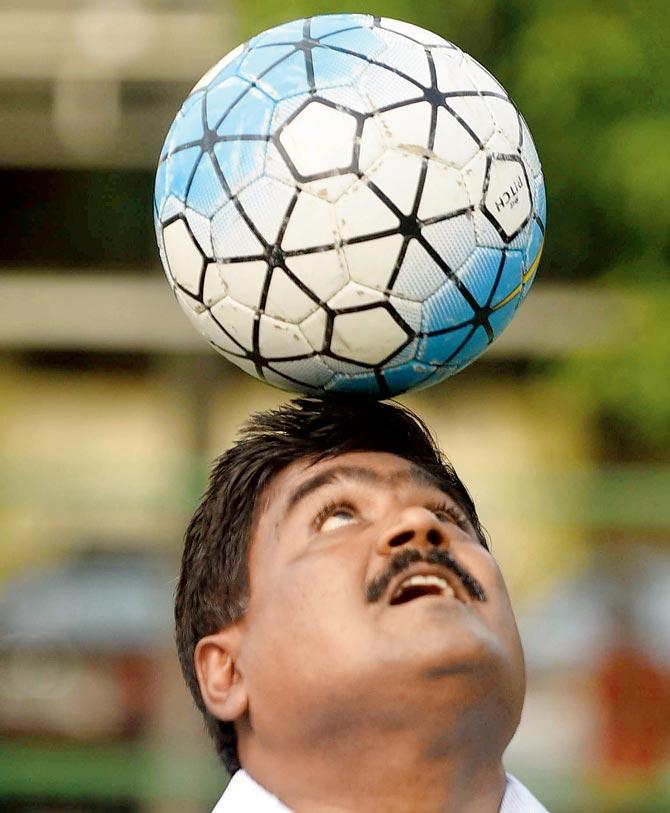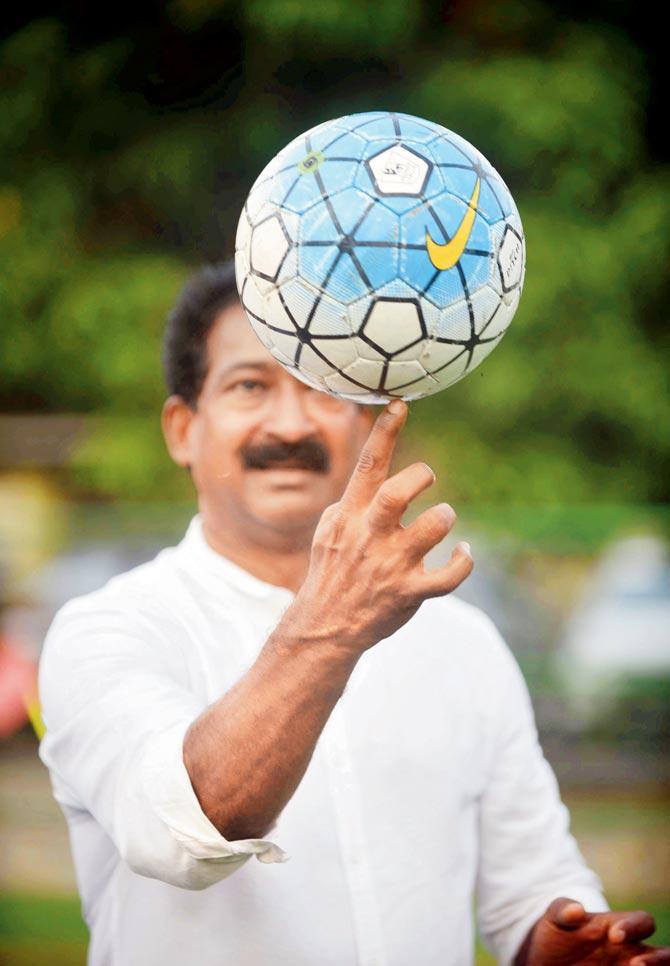Former India national team players Henry Menezes and Godfrey Pereira are a poster ad in optimism about the future of Mumbai football, as they tickle their memories and project a day when football will rival cricket.
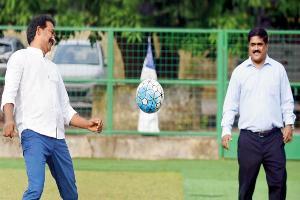
Henry Menezes and Godfrey Pereira. Pics/ Suresh Karkera
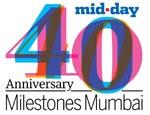 A lot has transpired across Mumbai's football fields in the last 40 years since Henry Menezes started playing. The number of teams at the Mumbai Schools Sports Association's (MSSA) tournaments has spiralled as have the number of clubs under the Mumbai District Football Association (MDFA). We have seen a progression from grass at Cooperage grounds, the only competitive football venue in the city then, to artificial turf, laid out by world governing body, FIFA. The Andheri Sports Complex now known as the Mumbai Football Arena hosted Mumbai's first international football fixture after a gap of 61 years in 2016, followed by the FIFA U-17 World Cup in Navi Mumbai. It's only expected then that when the former India goalkeeper meets former teammate and striker Godfrey Pereira, the two say, the grass is green on this side.
A lot has transpired across Mumbai's football fields in the last 40 years since Henry Menezes started playing. The number of teams at the Mumbai Schools Sports Association's (MSSA) tournaments has spiralled as have the number of clubs under the Mumbai District Football Association (MDFA). We have seen a progression from grass at Cooperage grounds, the only competitive football venue in the city then, to artificial turf, laid out by world governing body, FIFA. The Andheri Sports Complex now known as the Mumbai Football Arena hosted Mumbai's first international football fixture after a gap of 61 years in 2016, followed by the FIFA U-17 World Cup in Navi Mumbai. It's only expected then that when the former India goalkeeper meets former teammate and striker Godfrey Pereira, the two say, the grass is green on this side.
ADVERTISEMENT
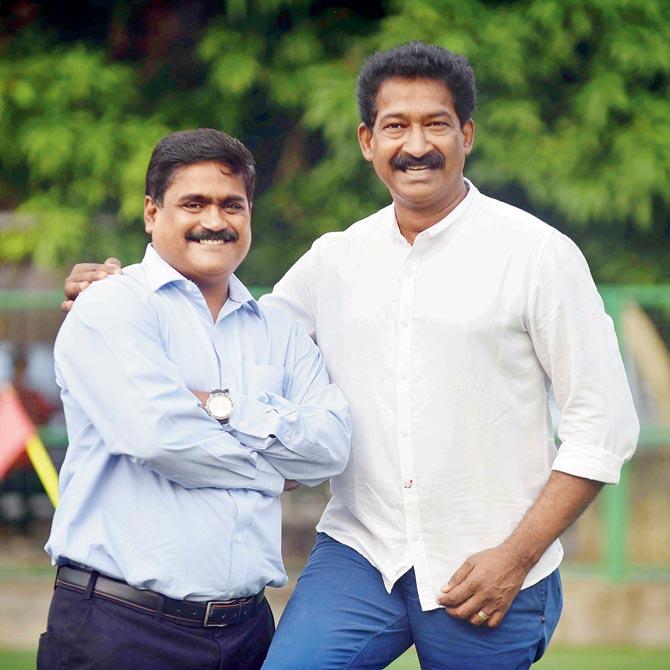
mid-day: You have had contrasting footballing roles. Henry, you were a goalkeeper and marshalled the troops from the back, while Godfrey was a forward. What was it like to play in Mumbai back in the 1970s?
Henry: I got into football in 1979. You tell me that's also the year mid-day launched. I joined the U-19 group, directly introduced to the game at the national level. Forty years ago, a grassroots or youth structure did not exist. The state competition was our only avenue. There was just one football ground, Cooperage. No TV either, so we couldn't watch any European football. For us, Bhaskar Ganguly, S Brahmanand and Bandya Kakade [former India goalkeepers] were the best goalkeepers in the world. Our icons were local.
Godfrey: I started playing in class II, at the age of eight. But I had to wait till class V when I was 12 to represent my school, St Paul's, Dadar, in MSSA tournaments. Because, back then, we started with U-13, unlike now when you start from U-8. My elder brothers, Wilfred and Dolfred, were my heroes. We had no knowledge of state or national-level tournaments. Once, while I was playing in an U-13 match at Cooperage, I was told by a coach to come for the Maharashtra state sub-junior selection trials. I went and got selected.
Watch the full video here.
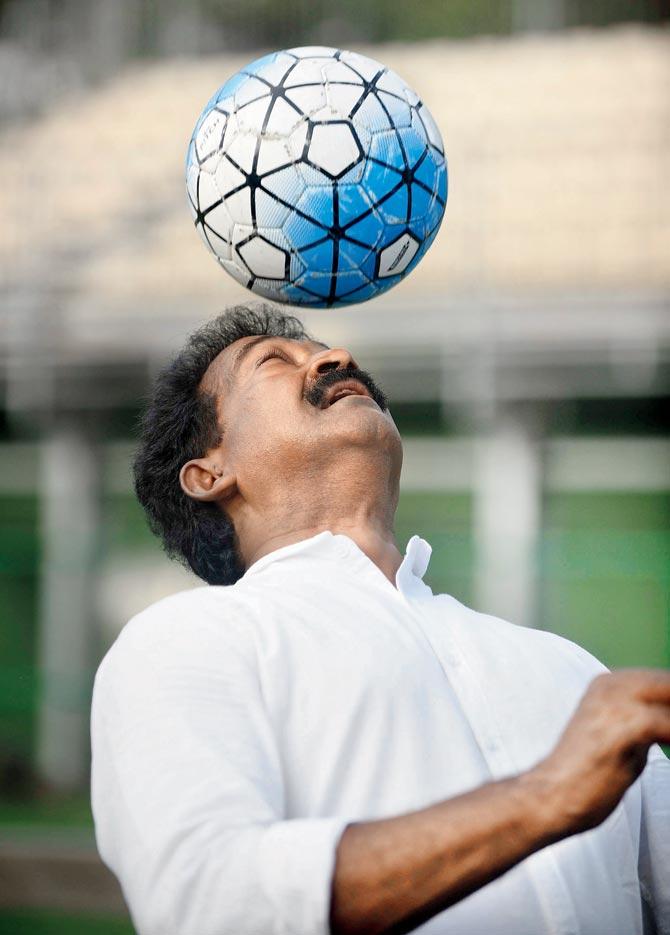
mid-day: School football has been the start for every aspiring Mumbai player. But has MSSA improved and contributed enough towards football's growth in the city?
Henry: MSSA is the first step for any child to fall in love with football. I represented my school [St Pius, Mulund] only once. The thought of representing your school for the first time in a competition, was exciting. And, when you scored a goal, your name appeared in small font in one corner of the newspaper. MSSA today has 1,400 teams. That's huge. But unfortunately, their infrastructure is still not up to the mark. The number of matches they conduct has put a strain on the body, leading to operational errors.
As CEO of the Western India Football Association [WIFA], I have tried to streamline things, like getting MSSA to play according to FIFA's [world football's governing body] structure, where the younger kids play 5v5, 7v7 and 9v9 and only when the child is 12 or 13 does s/he get to play 11v11. Most schools are keen to play 11v11 straightaway. But last season, we saw MSSA organise 5v5, 7v7 and 9v9, so that's our little contribution. In 2012, WIFA conducted the first 'D' license course for India and today, we have over 4,500 licensed coaches. That's 65 per cent of what India has produced! Today, almost every school that participates in MSSA tournaments has a licensed coach.
Godfrey: Yes. Earlier, mostly Catholic schools had good football teams, but that's changed. Don Bosco [Matunga] and St Stanislaus [Bandra] are doing well but teams like Jamnabai Narsee [Juhu] and Bombay Scottish [Mahim] have emerged too. Ground conditions have improved. We played on grounds that resembled paddy fields.
mid-day: MDFA has this massive responsibility of controlling football in Mumbai. And often, we see operational issues. How have they handled the growth?
Godfrey: To be honest, there has been no growth at MDFA. We used to have the Harwood League, which was one of the most prestigious not only in Mumbai but across the country. The organisation of tournaments was a lot better too. Having said that, we have more grounds in Mumbai including Andheri Sports Complex and the new Neville D'Souza turf in Bandra besides the Xaverian Ground in Parel. But I think MDFA needs to get professional.
Henry: I think you are being a bit harsh. In the 1980s, the game was detached from state associations and its administration was transferred to district associations. MDFA was formed in 1983 to run football in Mumbai. So, all the leagues here fall under MDFA and they had just one ground at their disposal — the Xaverian Ground. But now, with more grounds, MDFA will be better organised. They have good leadership in Aditya Thackeray and some other members, who are inclined to a professional approach.
mid-day: Yes, despite the challenges, Mumbai has contributed Rahul Bheke and Raynier Fernandes to the current Indian team. The last time this happened was around six years ago when Abhishek Yadav and Steven Dias played.
Godfrey: Both the boys have trained under me [chief coach] at Air India. I've been watching Raynier since he played for Don Bosco and I was coach of St Stanislaus. One look at him and I knew he is India material. But unfortunately, after class X, he disappeared from the football scene. Till class XII, he was nowhere. Then, I saw him with a friend in Vakola and asked him what he was up to. He said he gave up football because he did not get opportunities after school. I was stunned. I invited him to practice with the Air India team the next day. He did and the rest, as they say, is history. He did well for India in the King's Cup in Thailand.
Henry: When you talk of a dip in professional football, it's not about us having only two big players. Many players move out of Mumbai or Maharashtra for better opportunities. Like Thane boy Abhishek Ambekar, who played for Mohun Bagan or Mumbai lad Farukh Choudhury, who represents Jamshedpur FC at the ISL. So, there is no dearth of talent. There are 340 teams in the MDFA Leagues. In youth competitions [U-8, U-10, U-12, U-14, U-16] there are 275 teams. We have started Baby Leagues through 37 registered centres. In youth leagues, we have 17 teams, who have fulfilled the tough criteria for professional academies, which no other state has. We have the best coach education programme. We have four grounds [Cooperage, Bandra, Andheri, Parel] within 15 kms of each other, and are planning to get two more. After 60 years, Mumbai hosted international football at Andheri, in 2016. In 2018, we hosted the Inter-Continental Cup. In 2020, we will be hosting the U-17 girl's World Cup and in 2021, the U-20 World Cup. People say Kolkata is India's football hub. I say, it's Mumbai where football is all set to explode. In the next 10 years, by the time mid-day turns 50, Mumbai football would have realised its maximum potential.
mid-day: What about the club football scene?
Henry: We are following the Japan model. In 1991, Japan had institutional teams like Samurai and Suzuki, whom they got changed to city names. In 10 years, Japan jointly hosted the FIFA World Cup with Korea and their J-League became one of the best leagues in the world. That's the plan in India too. But as the Japanese told us, they spent millions of dollars. That needs to happen here. Right now, the AIFF is following FIFA's regulations which demand that clubs be professionally run, so things are a bit uneasy. But we do have some good academies still, like Reliance, which has a five-star rating.
Godfrey: We [clubs] feel sidelined because FIFA rules say they need professional clubs. We have played in the I-League for many years and currently, though we are not there, we are happy to serve as a training ground or a stepping stone, for players looking to make it big in the game.
mid-day: Sports jobs for athletes have reduced not only in football but also in hockey and cricket. But with football growing, have alternate careers emerged?
Henry: Look, not everyone will be a Baichung Bhutia or Sunil Chhetri but today football offers many alternate careers. Sports science is an important feature. Earlier, the coach was the sole boss. But now we have trainers, physiotherapists, nutritionists, psychologists, who are in demand. In Mumbai, we have a Diploma in Football Management, which is getting recognition from Mumbai University as a Degree. Then there is a course for analysts, where we teach everything from ground management to marketing. Also, there is stadium management, ticketing and media relations. A 'C' license coach today earns in multiples of a few lakh rupees.
Godfrey: I have many friends who have not done well as players but are still part of the game they love. They are referees or club coaches after doing 'D' or 'C' license courses and are well paid.
mid-day: The Indian Premier League has changed the game in cricket and Mumbai Indians have a huge fan following. Has the Indian Super League and Mumbai City FC had such an impact?
Godfrey: Definitely! Every player, who comes to Air India to train, dreams of the ISL.
Henry: ISL has changed the demography of football in India because they have got into prime time television. Mumbai City FC has brought in some of the world's best talent and that's why they have a huge fan following.
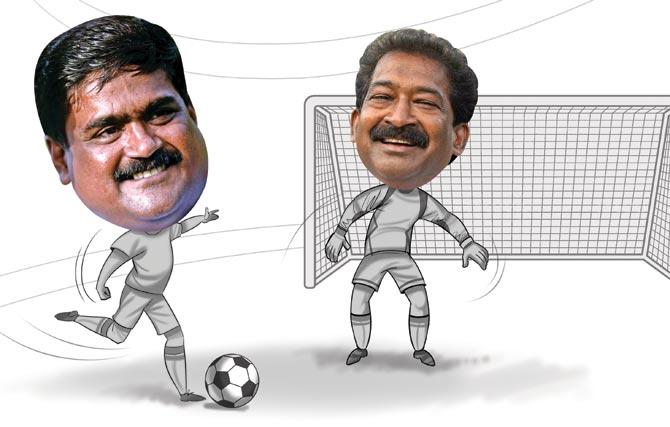
Illustration/ Ravi Jadhav
mid-day: The football world can get better for women. There is obviously huge potential to tap.
Godfrey: When we played, there was no women's football. But today, there are many women's teams and talented players. That's great!
Henry: Yes. Women's football has traditionally been inter-district competitions, and in 2011, there were six to eight districts involved. The lack of coaches and a conservative mindset that didn't allow daughters to play football was a hurdle. So we initiated coach education work and today. In seven years, we have grown from eight to 28 districts that compete across two categories, sub jr and senior. So, that's 28 and 28, 56 teams in all. In Mumbai, we started the women's league where we have 14 teams now. Even a women's football powerhouse like Manipur has just six.
Catch up on all the latest Mumbai news, crime news, current affairs, and also a complete guide on Mumbai from food to things to do and events across the city here. Also download the new mid-day Android and iOS apps to get latest updates
 Subscribe today by clicking the link and stay updated with the latest news!" Click here!
Subscribe today by clicking the link and stay updated with the latest news!" Click here!







